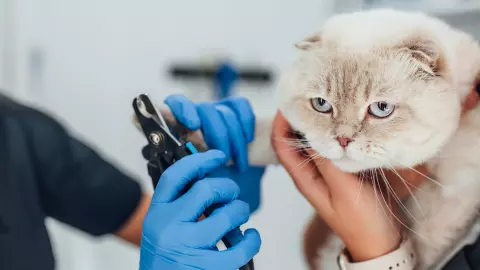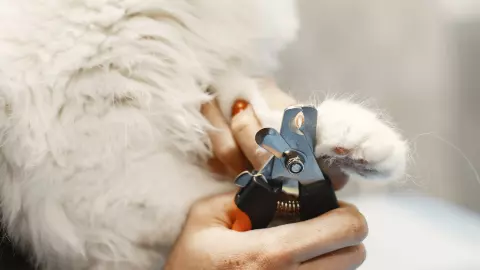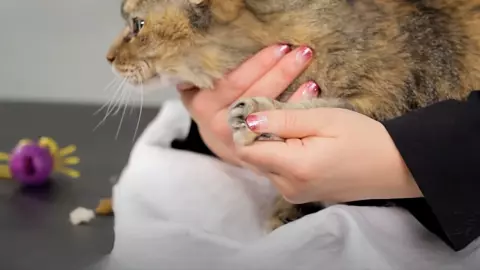Declawing is a controversial procedure that removes the cat’s claws. It’s mostly like cutting off your fingers from the last knuckle. Due to the potential harm that it may cause, this is illegal in many countries.
Although declawing has been outlawed in many countries, the United States still has it. So, how much does it cost to declaw a cat? You need to spend between $200 to $1800 to declaw your cat depending on the veterinarian, location, and other factors.
The cost is estimated with the pre-care, surgery, and post-care expenses. However, we have brought more things to your attention. Let’s get to know!
Declawing: What Is It And How Much Does It Cost To Declaw A Cat?

Declawing means removing the final segment of each toe bone of your cat. This is done to prevent cats from scratching furniture or humans.
Cats are naturally intended to scratch their surroundings and surface. Their innate nature is to mark their territory, so they use their claws for this. However, some people tend to declaw their cats to be safe from all the scratching.
Cost: The cost of declawing a cat can vary depending on the veterinarian, area, and other factors. There are pre-testing surgery, and post-surgery expenses that you need to keep in mind. However, overall, declawing your cat may cost around $200-$1800.
The cost also depends on the age of your cat. Usually, young cats require less cost to declaw as they are already undergoing anesthesia for spay or castration.
Declawing a cat can involve several different costs, including pre-testing, anesthesia, the declawing procedure itself, and aftercare. Also, the longer the procedure is for your cat, the higher the cost will be.
Cost Depending On The Stages:
Firstly, your cat will undergo a pre-testing phase where a medical checkup is done to ensure that your cat is good to go under the declawing process. This may include several tests, blood work, and other physical examinations. The cost varies depending on the type and quantity of tests.
Once the checkup results are positive, your cat will undergo the anesthesia process. This costs around $25 to $75. But this may also vary depending on the cat’s age, size, and overall health.
Then comes the declawing techniques. Several declawing techniques cost different. Here is a glimpse:
| Technique | Estimated Cost |
|---|---|
| Onychectomy | $140 To $500 |
| Disarticulation | $100 To $500 |
| Laser Method | $200 To $1200 |
Finally, once the declawing is done, you need to pay for the aftercare. This may cost around $100 depending on the services. Sometimes, your cat may need further monitoring, this will also add up to the cost.
Does PetSmart Declaw Cats?
Yes, you can declaw your cat from PetSmart. They have two available options for 2 paws and 4 paws. The age limit for the process is 2 years.
Cost: The cost of PetSmart’s declawing varies from $100-$700.
How Are Cats Declawed?

There are 3 methods that veterinarians use to declaw a cat. Out of them, the Onychectomy is the most popular one. Here is the procedure for all three:
1. Onychectomy
This is the most common procedure that people choose. But it can be pretty painful for your cat. The procedure requires your cat to go under general anesthesia. When your cat is out of sense, the surgeon removes the entire last bone of each toe that contains the claw.
The surgeon amputates the surrounding tissue, nerves, and tendons alongside the claw. Once the effect of the anesthesia goes away, the cat may experience significant pain, discomfort, and bleeding. So, your cat will need several days or weeks of rest after the surgery.
2. Disarticulation
Although most people don’t go for it, it still exists. The process requires the surgeon to remove the joint that connects the last bone of each toe to the rest of the foot. This is less painful and invasive than the before-mentioned one. So, it has a shorter recovery time.
3. The laser method
This is a newer method that’s gaining popularity as the amount of pain that the cat goes through is not extreme. In this procedure, the laser surgeon uses a laser to vaporize the tissue around the claw.
When the laser is applied, it removes the claw and prevents bleeding. However, this method is also performed under general anesthesia.
What Are The Disadvantages Of Having A Cat Declawed?
Pain and discomfort
Due to the amputation of the bone, the cat may feel extreme pain and discomfort. Also, it may impact the lifestyle of the cat.
Potential for complications
Sometimes, the surgery may bring complications like bleeding, infection, and poor wound healing. If the aftercare isn’t done properly, it may even be life-threatening.
Physical consequences
Declawing may cause extensive issues that will cause long-term physical consequences for the cat. Your cat may get effects like changes in gait, arthritis, and chronic pain.
Psychological effects
Once the procedure is done, your cat may get psychological issues like changes in behavior, increased anxiety, and decreased quality of life. Due to the trauma that the surgery causes, your cat will feel more scared all the time.
Inability to engage in natural behaviors
Scratching is a natural behavior for cats. They tend to use this innate aspect to protect themselves, as a form of stress relief, and territory marking. As a result, declawing will prevent your cat from conducting innate behaviors.
Is Declawing Your Cat Bad For The Cat’s Health?
Yes, it is. This can bring several complications in the cat’s life and it can also be life-threatening. During the surgery, the loss of a lot of blood may increase the risk as well. Declawed cats feel acute and chronic pain after the surgery.
Also, declawing prevents a cat from taking part in its natural behaviors. This also increases the risk of changes in gait, behavioral problems, anxiety, and arthritis. Must to mention, they may also fall into a greater risk of developing litter box problems.
Are There Alternatives?

Declawing is a painful procedure that can cause acute and chronic pain in the cat. If you are looking for alternatives, you can do regular nail trimming. This is a safe and effective way to keep a cat’s claws short and blunt.
Moreover, there are nail caps that you can attach to the cat’s claws to prevent scratching. The caps are glued onto the claws and last for several weeks before falling off naturally. You can also give your cat training to discourage them from scratching other surfaces.
Further Information To Explore
1. Is it OK to declaw an indoor cat?
You shouldn’t declaw an indoor cat unless it’s due to medical reasons. You can prevent your cat’s scratching by adapting to other methods. But declawing a cat because of scratching is not suggested.
2. Is declawing a cat painful?
Yes, your cat will feel extreme pain after the procedure. Your vet will prescribe medicines to manage the pain. There are other consequences like bleeding, swelling, and infection.
3. Can a declawed cat live a happy life?
Declawing may bring several changes to the cat’s lifestyle. As you are hampering its regular innate behavior, it might develop psychological issues. Most declawed cats behave differently once the process is over.
4. Is laser declawing better?
If you compare it to the other available methods, laser declawing is better as it causes less pain to the cat. Besides, there will be less bleeding during the process.
Wrapping Up
As you know how much does it cost to declaw a cat, declawing shouldn’t be a problem anymore. But we highly discourage this as the cat may undergo a lot of pain. Declawing a cat seems inhumane, so it’s outlawed in many countries. If your cat scratches a lot, you may rely on other methods like nail trimming, using nail caps, and so on.

Hello, this is Frank Swanson, the owner, and operator of Pet Info Hut. I created this website as a way to share my love of pets with the world. I have over 7 years of experience working with animals, and I have a passion for helping people care for their pets. I hope that you find my website useful and informative. Thanks for visiting!

